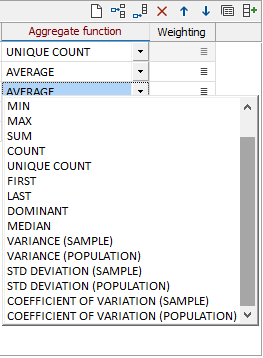Aggregate Fields
On the Aggregate Fields tab of the Report Generator form, use the Field Mappings grid to configure the fields from the input file to be included in the output file.
Field Mappings
Use the Fields Mappings grid to setup the fields to be read/derived from the input file for transformation/copying to the output file. Use the buttons on the local toolbar to Manage the rows in the list.
The grid list accepts the following settings for each field:
Input
A field from the Input file. (An Auto-fill option on the toolbar can be used to populate the grid with all the fields in the input file.)
The input field may also be a complex expression which evaluates as a character string, for example:
=if ([au] >5) then "HIGH GRADE" else "LOW GRADE" endif"
Field Name
The output field name. If this entry is left blank and the entry for the input field is not an expression, the input field name is used.
Type
The output field type. If this entry is left blank and the entry for the input field is not an expression, the type of the input field is used.
Format
The format options you can select for a field will depend on the type of field. For more information, see: Formatted Types
Width
For Character and Numeric fields, specify the width of the field.
Decimals
For Numeric fields, and Real or Float binary fields, the number of decimal places.
Description
Allows the purpose and the content of a field to be described using a maximum of 255 characters.
Aggregate Function
Select the function to be used to aggregate field or expression values. WGT AVG is the default for Real or Float fields. DOMINANT is the default for Character fields. Statistical functions are available for selection, such as median, sample variance, population variance, sample standard deviation and coefficient of variation.

Weighting
When the Custom Weighting grouping function is selected, either the name of the weighting field, or a complex expression.
